BMW presented its very first M3 model during the Frankfurt Motor Show in Germany. Three decades later, the new power-machine F80 M3 is premiered in the same place where it had all begun. It was truly a remarkable transformation that the world has witnessed for the BMW M3.
“Four generations of the BMW M3 have blended Motorsports genes and uncompromised everyday usability within an emotionally rich overall concept,”
This was how Dr. Friedrich Nitschke, President of the BMW M GmbH described the latest BMW M3.
The New Generation of BMW M3

Like its sibling the BMW M4 Coupe, the latest M3 has incorporated Comfort Access Keyless Entry (previously a Convenience Option) and the Harman Kardon Surround Sound Audio System, which provides vehicle-specific equalizer and a 600-watt amplifier (previously an Entertainment Option). Additional modifications were made to the M3 interior and exterior showing reworked trims and lighting.
See our complete guide to the BMW M3 history and evolution.
What is so Extraordinary about the New F80 M3 Sedan?
Debuted at the North America International Auto Show in January 2014, BMW revealed the fifth generation of the F80 M3 Sedan along with the F82 M4 Coupe. Streets with speed limits cannot possibly be a fair judge of the M3’s potential.
If you have had the opportunity to tear down the tracks with this revving 425 HP in-line 6-cylinder, you will notice the enhanced aerodynamic balance, the amped 406 lb-ft of torque and the impressively precise steering that the M power delivers.
Track-ready Powertrain Technologies in the BMW M3
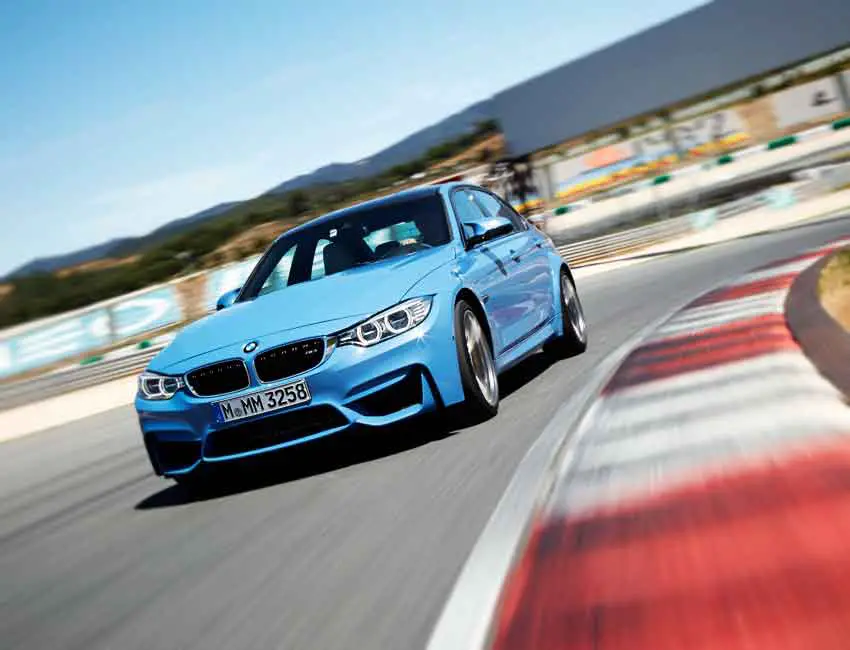
The BMW engine developed for the M3 embraces the true racing attitude of the new sedan. It took more than the best team of mechanical and electrical engineers to configure the perfect synthesis for the new four-door performance sedan.
Deutsche Tourenwagen Masters (DTM) professional racers Bruno Spengler and Timo Glock worked closely with the team to develop, refine, and meticulously access performance mechanisms of the vehicle at the Nürburgring-Nordschleife circuit to craft a truly competition-spirited racing icon.
The BMW M3 Engine with M TwinPower Turbo Technology
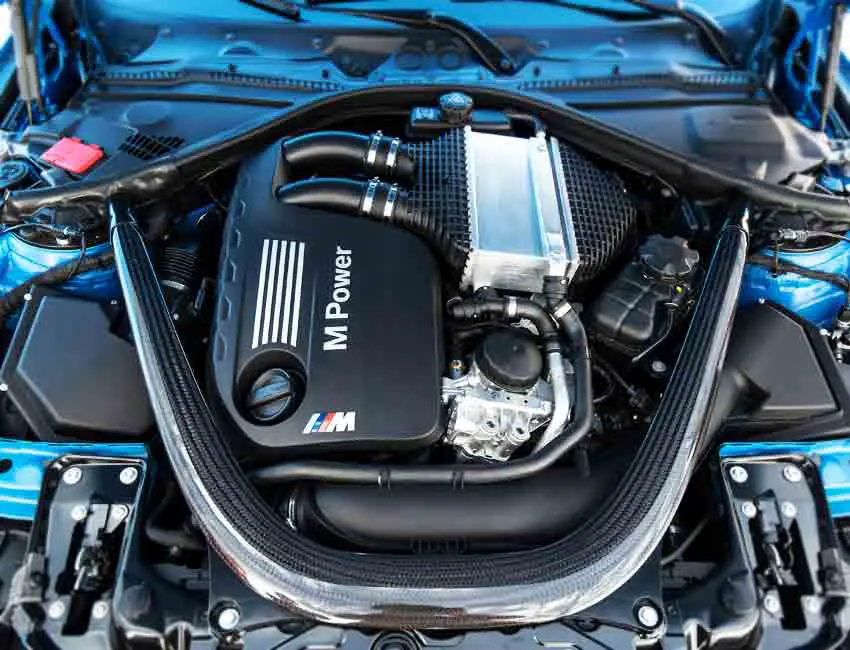
Shaving off roughly 22-lb from the engine alone, the new M3 comes with improved fuel conservation and pollutant emission. The in-line 6-cylinder engine paired with M TwinPower Turbo technology customized for the M3 Sedan has outdone its former generation in consumption (25% less), peak torque (40% more) and power output (11 more horsepower).
The 4-door sedan reaches 0-60 mph in just 3.9 seconds with the added Performance Option 7-speed M Double Clutch Transmission (M DCT) with DriveLogic. It finishes the same race in 4.1 seconds with the standard 6-Speed Manual Transmission.
The In-line 6-cylinder is not an entirely new concept to the M3. BMW introduced this design for the earlier generations. Multiple times it has snatched “Engine of the Year” Awards.
Combined with the M TwinPower Turbo technology, which incorporated Valvetronic Full Variable Valve timing and Double-VANOS, peak torque is consistently ensured over a broad range of RPM. This electronically controlled system delivers precise response and increased power with lower fuel consumption.
“As a race driver, I’m very impressed by the instant, lag-free response from the two turbos as soon you step on the gas” commented by DTM professional racer Bruno Spengler. “This is a sensational feature of this engine which translates to more fun at the wheel and is perfect for sporty driving.”
Sophisticated Engine Oil Supply System in the BMW M3
The advanced engine oil supply system is designed with a special cover that limits oil movement during abrupt accelerations. Consistent engine oil circulation is achieved with the oil return system and extraction pump. It ensures proper supply of oil to every part of the engine system during relax cruising or aggressive driving.
BMW M3 Performance Achievements
One of the development priorities of the BMW M3 has always been to closely imitate the capabilities and technologies of the Motorsport track version. Car of such caliber requires all working components to be of meticulous standards, fitting the capacity of high-performance race car requirements.
M Compound Brakes vs. Carbon Ceramic Brakes
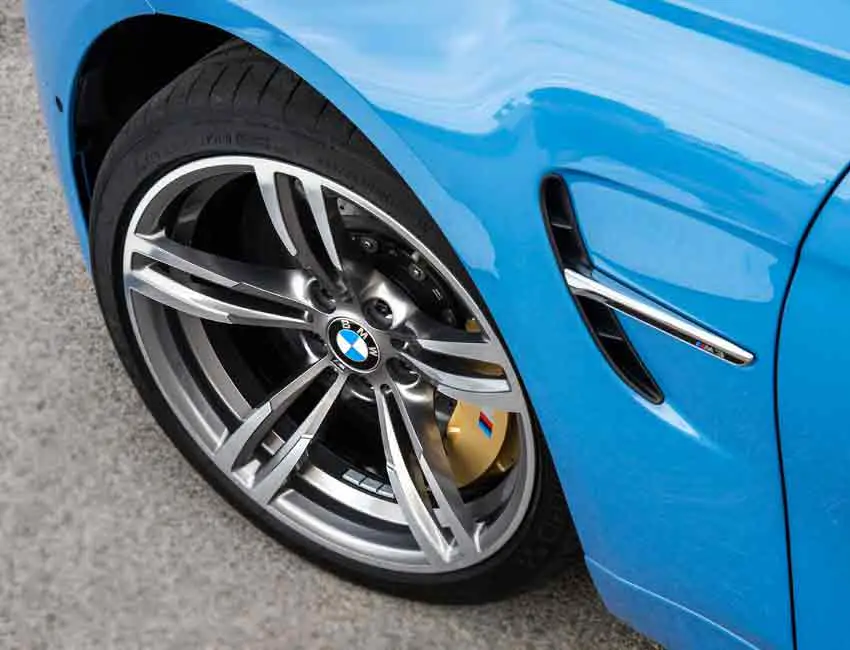
The BMW M Compound Brakes
The M Compound Brakes come in metallic blue calibers on the new BMW M3s and M4s. The combination of resilient materials such as the aluminum brake cover and grey-cast iron brake discs used for the M Compound brake system are specially designed by the BMW M engineer Klaus Dullinger.
The M Compound Brakes are built to handle the rigorous performance requirements of the M engines. The brakes are constructed to serve longer lifespan, handle heat exchange more efficiently, and provide improved precision during braking as well as weight reduction in the brake itself.
To learn more, refer to our complete guide on the BMW M3 M Compound Breaks.
The BMW M Carbon Ceramic Brakes
BMW offers M Carbon Ceramic Brakes as a Performance Option for drivers looking for brakes that can handle even the most intensive track actions. The 19-inch wheels is an required upgrade for the Carbon Ceramic Brakes.
What’s in it for you? The Carbon Ceramic Brakes offer more stability and performance than the conventional brakes. According to BMW, they are guaranteed maximum braking performance under all weather conditions. They are more durable and do not corrode. Their silicon carbide friction coating is extremely resilient and does not wear easily. If you are always roaming the tracks or roaming the streets like you are on the tracks, these might be a worthy investment.
Want to know more? Refer to our complete guide on the BMW M3 M Carbon Ceramic Breaks.
The Light Weight Aluminum Suspension in the BMW M3
One of the key redesigned mechanisms in the new BMW M3 F80 is the axle system. The idea was to create a world-class dynamic driving experience while maintaining the most precise steering with timely response and ideal directional stability as well as exceptional traction control without losing the edge of speed (sounds cool, right?) Yes, it is quite an ambitious quest, but BMW MGmbH has yet again outdone itself.
BMW engineers revamped the traditional steel suspension system in order to construct a lightweight but firm and sturdy axle system. Forged aluminum was heavily incorporated to construct parts of the double-joint spring strut front axle and the new five-link rear axle components such as the wheel carriers, subframes, and control arms.
Furthermore, instrument pieces such as the lay-free ball joints and elastomeric bearings are custom designed exclusively for the M3 to provide the most optimal transfer of lateral and longitudinal forces.
Aerodynamically Engineered Designs in the BMW M3
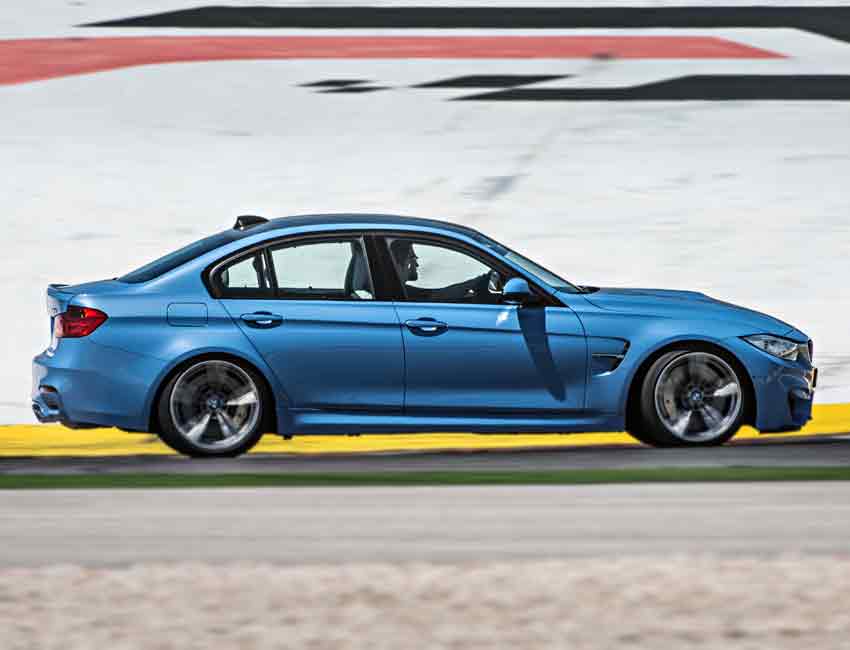
Building an aerodynamic structure has always been the quintessential development goal of BMW M GmbH.
In an effort to put together an impeccable track oriented model, the team worked every detail of this vehicle. Changes included a new carbon-fiber-reinforced plastic (CFRP) roof, restyled front fenders, side gills and twin-stalked power-adjustable, and new auto-dimming side mirrors for optimal dynamics such as drag reduction and cooling.
First in its Class M Servotronic with Electric Power Steering (EPS) in the BMW M3

The Electric Power Steering is part of the BMW EfficientDynamics standard features. It adjusts the vehicle’s level of steering with the integrated Servotronic function in conjunction with the driving speed to properly apply the ideal amount of steering control at all speeds.
Steering assistance is applicable to all three drive modes (“COMFORT,” “SPORTS,” and “SPORTS PLUS (+)”) under Adaptive M Suspension to suit individual driving preferences.
Benedikt Nussstein is responsible for the development of the first electrical servo-assisted steering system in the M class. He explained during his interview and discussed the significant improvement of the new steering system over the previously adopted hydraulic servo-assisted system:
“The new M Servotronic with Electro Power Steering (EPS) weighs about 3.5 kg (or 7.7 lbs) less than comparable systems with hydraulic servo-assisted steering, which is important when it comes to creating an optimum axle load distribution and in turn ensuring agile handling. The new steering saves approximately 0.3 liters of petrol per 100 km (or 62.1 miles) because the energy is only consumed when actually steering, while a hydraulic pump represents a constant drain on power. And by using EPS it is also possible to install the latest driver assistance systems.”
Aerodynamics Cooling Concept in the BMW M3
To accommodate a powerful engine, the performance-focused BMW M3 also requires an exceptional temperature control system that can handle the tracks and extensive daily use. The M3 cooling system constructed with racing specs maintains the temperature level in the drivetrain to ensure an ideal temperature balance.
Revamped Air Intakes are now located in the front fender region of the M3. It is positioned near the turbocharger units and equipped with indirect intercooler and electric coolant pump. Air Breather and Air Curtain are both designed for added cooling and assist turbulence reduction in the front wheel arches.
The Gurney Spoiler on the BMW M3
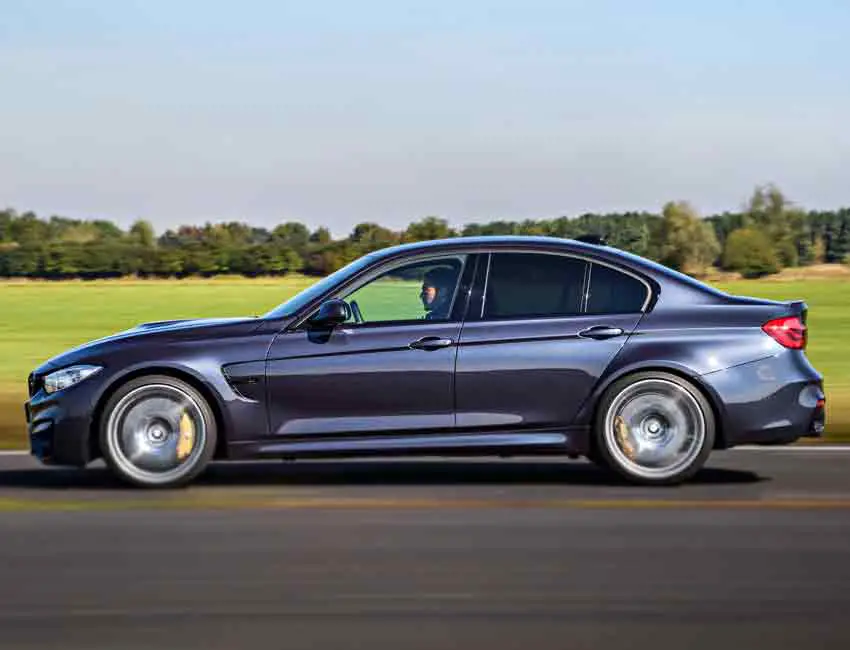
The rear spoilers on the BMW M3 Sedan and the M4 Coupe are drastically different in design. While the M4 receives an integrated rear spoiler, which extends seamlessly off of the painted carbon-fiber-reinforced-plastic (CFRP) trunk lid, the M3, on the other hand, is tailored with a Gurney Spoiler. Both spoilers possess outstanding abilities to improve the aerodynamics of the drive and reduce drag by pushing the air down to the rear of the car.
There is, however, something very special about the BMW M3 Gurney Spoiler. Named after the racer Dan Gurney, the spoiler is often referred to as a Gurney Flap or a wickerbill in the States. The wing-shaped design provides downforce in the rear to keep the car grounded. A rotating body of air is formed from the air clusters pushing in opposite directions immediately above and below the flap, which causes increased downforce.
Carbon-Fiber-Reinforced-Plastic (CFRP) Elements in the BMW M3
Carbon-Fiber-Reinforced-Plastic (CFRP) Roof
In the past, the sporty carbon fiber constructed roof was always featured in the BMW M3 Coupes. BMW is now bringing the remarkably light and rigid material to the new M3 F80 4-door Sedan for the first time. It achieves a total weight reduction of approximately 13 lbs. The result is reduced curb weight and increased efficiency.
Carbon-Fiber-Reinforced-Plastic (CFRP) Drive Shaft
The Carbon-Fiber-Reinforced-Plastic (CFRP) Drive Shaft feeds the engine’s torque from the gearbox to the rear differential. It works under extremely heavy loads in high-performance vehicles like the BMW M3. The CFRP Drive Shaft is a single-piece structure with no center bearing. The lightweight of the material reduces rotation mass and yields faster response in acceleration while improves driving dynamics.
BMW M3 Exterior – When Power Meets Magnificence
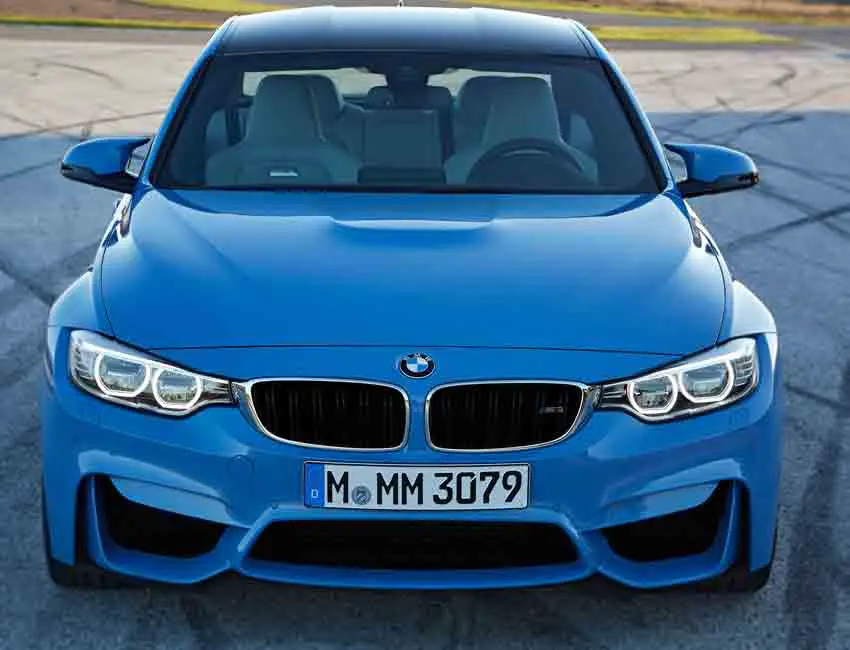
We are impressed with the lean and mean yet sophisticated BMW M3 Sedan. Prevailing yet practical, the exterior Shadowline Trim flows subtly into the perfect contour of the body shell. It is more than just an “eye-catching style”. It draws an emotional connection between the car and its driver.
The BMW M3 Sedan Versus the BMW M4 Coupe
The BMW M3’s distinctive characteristics are expressed through its design. Inherited its legacy from the previous generations, the Sedan still encompasses many of the distinguished features that make the M3 a benchmark sports car.
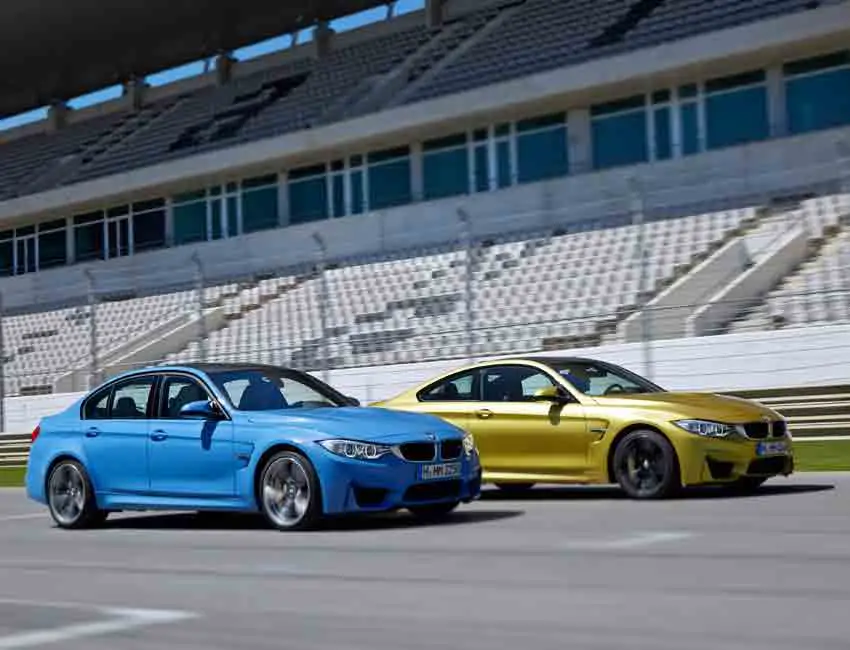
Sharing the same low stance as the M4 Coupe, the BMW M3 F80 Sedan measurements are as below:
- 183.9 inches in length (same as M4 Coupe)
- 73.9 inches in width (0.3 inches wider than M4 Coupe)
- 56.0 inches in Height (1.6 inches taller than M4 Coupe)
- weight in at 3540 manual/3595 DCT (10 lbs. heavier in both manual and DCT than the M4 Coupe)
At a glance, other than the few stated built differences, the BMW M3 Sedan and the M4 Coupe share almost identical stats on performance and transmission specs. Both the M3 and M4 design show off aerodynamic characteristics. Begin with the iconic power dome on the aluminum hood, which is suggestive of the powerful turbocharged in-line 6-cylinder engine lying beneath.
In the front view, the equally distinctive Adaptive Full LED Lights with Automatic High Beam are available as a lighting upgrade option. The aluminum fenders, the M logo embossed black twin kidney grilles, the redesigned front Air Intakes, Air Breather, and Air Curtains all contribute to the cooling of the engine and the brake systems in the BMW M3 and M4.
Profile wise, besides the sleek and sporty Shadowline Exterior Trim, the most prominent features are the signature twin-stalk mounted automatic side view mirrors, enlarged wheel arches with M designation bearing side gills, and the M double-spoke wheels in the optional 19-inch black light alloy.
Last but not the least, both the BMW M3 and M4 share the same Carbon Fiber Reinforced Plastic (CFRP) structured roof in an unpainted finish while the CFRP on the trunk embodies the same color as the body paint.
The BMW M3’s Sleek Interior Design
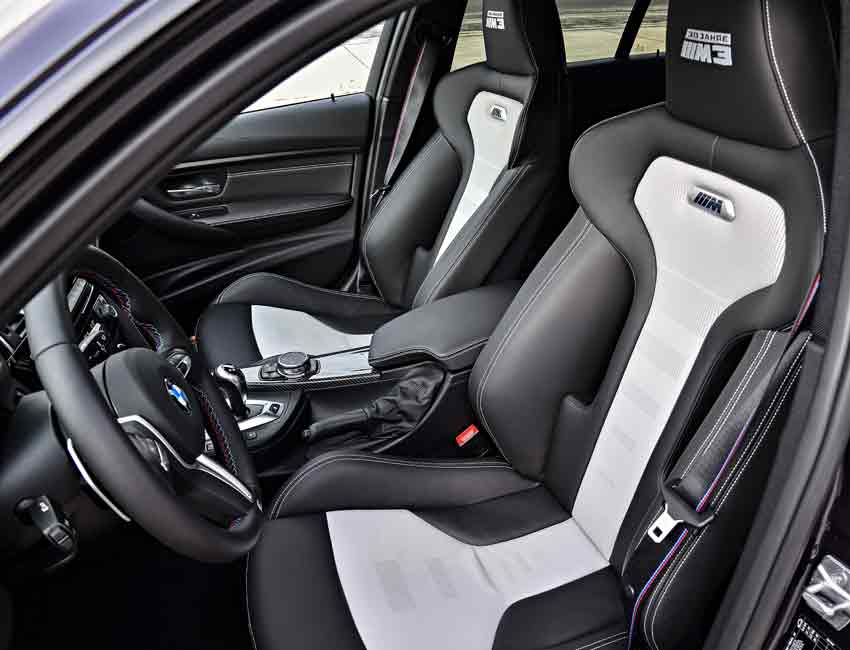
There was an overall upgrade to the interiors of the BMW M3 F80 from its predecessors.
The 10-way power front M racing bucket seats equipped with adjustable side bolsters, 4-way lumbar support, 3 stage heating, and memory settings are ergonomic designs fitted for the new M3 Sedan. Spacious back seats feature a lightweight composite material, with comfortable back support and can be folded into a 60:40 split.
The Carbon Fiber interior trim by manufacturer default can be upgraded to the luxurious BMW Individual wood trims at an additional cost.
M logo furnished instruments in the M3 include door sill finishers, M driver’s footrest, M gearshift lever, lite-up M logo on the backrest of the front seats, M designations on the steering wheel with tri-color stitching, and the electroplated-lock shift paddles with the optional 7-speed dual clutch transmission.
The BMW M3 Interior Gadgets
Technology-wise, the BMW M3 is fully equipped with the latest state of the art gadgets catering to the convenience and practicality of daily drives.
The Updated iDrive in the BMW M3
The updated iDrive is part of the high-resolution Navigation System. The 3D maps come with voice command and feedback as well as a 200 GB internal hard drive with 20GB just for audio files.
Convenience Option in the BMW M3
Convenience Option includes enhanced hands-free Bluetooth with Smartphone Integration, Power rear sunshade and the handy Parking Assistant. The Parking Assistant can search for available spots and takes care of steering for the driver when parking.
New Head-Up Display in the BMW M3
Head-Up Display within the optional Executive Package offers front windshield projected display of M-specific functions such as gear display, rev counter, and Optimum Shift Indicator.
Safety Option in the BMW M3
Side and Top View Cameras are a good choice if you are looking for added security and safety. They provide better blind-spot visibility than just eyeballing.
Driver Assistance Plus Package in the BMW M3
Driver Assistance Plus Package contains safety features such as the Active Driving Assistant, Active Blind Spot Detection, Speed Limit Info, and Side and Top View Cameras (also available as a stand-alone option).
The M Laptimer App for the BMW M3
The free M Laptimer App (available to download in the iTunes app store) can be accessed through the iDrive Controller once downloaded to smartphones. A range of performance data such as speed, acceleration, engine RPM, steering angle, fuel consumption, etc. can be recorded and displayed with visual presentation through the app on the smartphone.
A range of performance data such as speed, acceleration, engine RPM, steering angle, fuel consumption, etc., can be recorded and displayed with visual presentation through the app on the smartphone.


